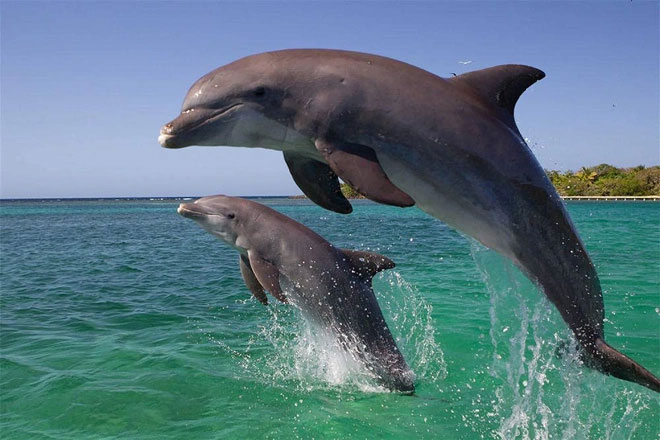Female dolphins form a 'baby group' when raising cubs
Friendly bottlenose dolphins live in groups of up to 100. Intelligent and highly social, dolphins do everything together, including raising their young in babysitting groups. Dolphins use sound to communicate with each other. Each dolphin has its own whistle. This helps them recognize each other, seek out, and help each other.

Dolphins are intelligent animals.
Dolphins mainly eat small fish and squid. They use echolocation to find their prey, a technique known as echolocation. Dolphins jump out of the water to get a better view of their prey, and can swim at speeds of up to 30 km/h (19 mph).
During breeding, the male dolphin will wait for a female to swim into his area or he will actively seek out a mate. The dolphins will then swim side by side, rubbing their bellies against each other as they mate. Female dolphins are pregnant for 12 months before giving birth.
The mother will teach her newborn to swim right next to her. The mother dolphin swims, her body creating waves to push the baby dolphin to glide through the water with her. At birth, the baby dolphin is pushed to the surface by the mother dolphin or another female in the herd so it can breathe air. Like all mammals, dolphins have nipples and breastfeed their young. The baby dolphin sucks while the mother is swimming, every 4-5 seconds.
In each colony, there are small groups with babysitting functions, including the mother fish and the fry. Female dolphins even care for the offspring of other mother fish. This is called 'alloparenting'. The female dolphins form a group to protect the baby dolphins from predators such as sharks. Dolphins breastfeed until 2 years old and stay with mother dolphins for 3 to 6 years.
Cooperative feeding also occurs in sharks. After 10-12 months to the time of childbirth. The female shark will swim to the edge of the mangrove. This is the 'nursery', where its young will spend their first years of life. Baby sharks are born near special 'nursery' areas, such as coastal mangroves. Here, there is plenty of shelter and food to give the chicks the best chance of survival.
- Secret female contraceptive weapons of female dolphins
- Touched by the mother dolphin giving her body
- The male dolphin choirs to lure the mating female
- Watch the lovely 'baby' animals
- Video: Winged mother chickens protect the cubs in the stormy weather
- Heartbreaking picture: The stranded dolphin in Florida is full of plastic waste in the abdomen
- The miracle of raising children with father's milk
- Dolphins die massively along the US coast
- Discover new humpback dolphins near Australia
- Mother dog raising tiger
- Revealing new ancestors of modern dolphins
- Young dolphins save the herd of more than 100 pigs from the strands
 Surprised: Fish that live in the dark ocean still see colors
Surprised: Fish that live in the dark ocean still see colors Japan suddenly caught the creature that caused the earthquake in the legend
Japan suddenly caught the creature that caused the earthquake in the legend A series of gray whale carcasses washed ashore on California's coast
A series of gray whale carcasses washed ashore on California's coast Compare the size of shark species in the world
Compare the size of shark species in the world